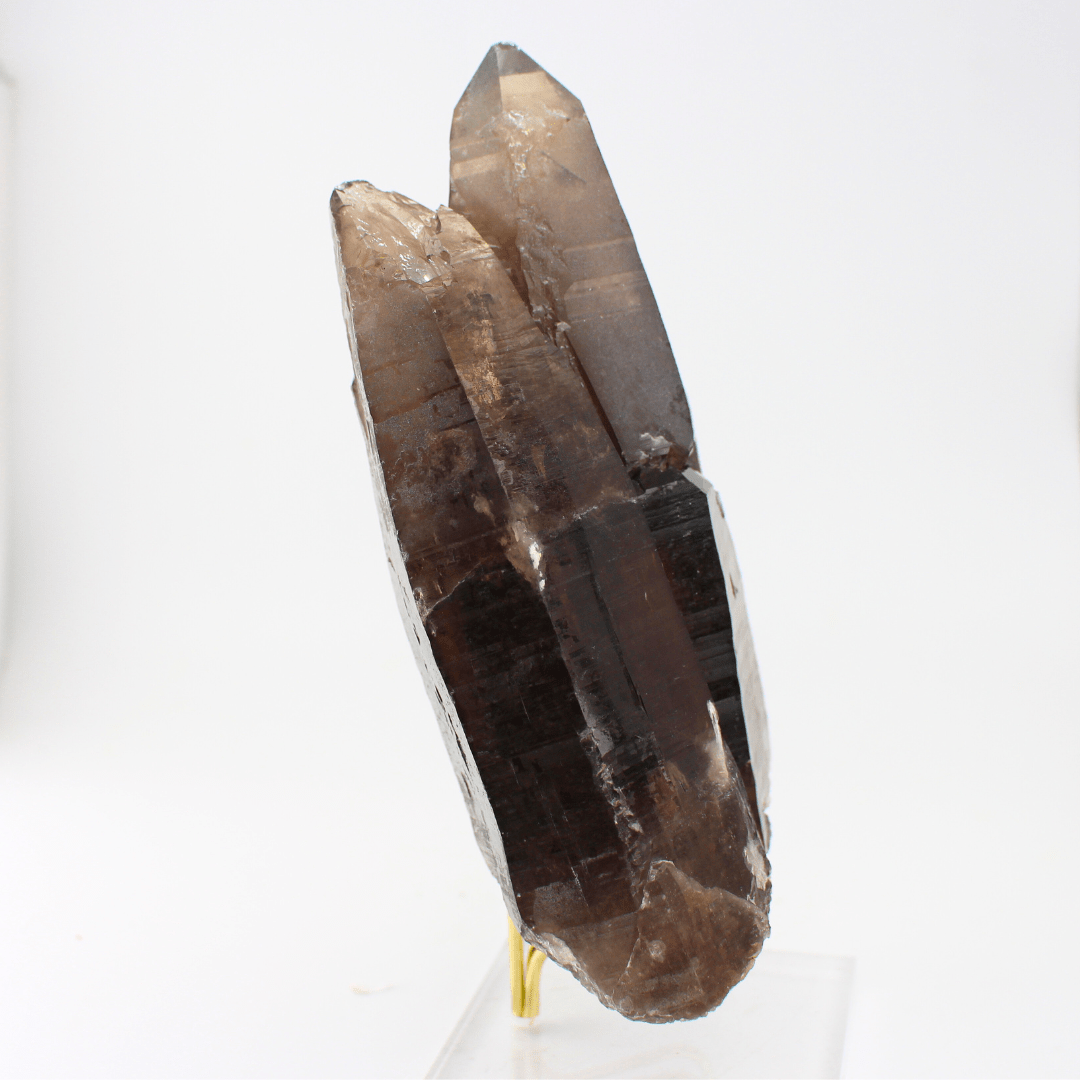SKU:S1153g
Smokey Quartz Rehealed Fracture Gastein Austria 1153g
Couldn't load pickup availability
Smokey Quartz Rehealed Fracture Gastein Austria 1153g
Quartz: The Universal Crystal of Pure Radiance Quartz, a ubiquitous mineral found abundantly in Earth's crust, is a crystalline wonder known for its exceptional clarity, diverse colors, and versatility. As one of the most recognized and varied gemstones, quartz holds a unique place in geological formations, human history, and contemporary applications. Physical Characteristics: Color: Quartz boasts an extensive color palette, ranging from clear (rock crystal) and white (milky quartz) to vibrant hues such as purple (amethyst), yellow (citrine), pink (rose quartz), and smoky gray (smoky quartz). The variations are attributed to the presence of different mineral impurities during formation. Transparency: Transparent to translucent, quartz crystals showcase remarkable clarity, allowing light to permeate and create a radiant glow. Crystal System: Crystallizing in the hexagonal system, quartz forms six-sided prisms terminated with pyramidal points. Varieties: Amethyst: Renowned for its regal purple color, amethyst is a prized variety of quartz often associated with spiritual and calming properties. Citrine: Boasting warm yellow to golden-brown tones, citrine is linked to positive energy and abundance. Rose Quartz: Exhibiting gentle pink hues, rose quartz symbolizes love, compassion, and emotional healing. Smoky Quartz: Characterized by a smoky gray to brownish hue, smoky quartz imparts an earthy and mysterious charm. Properties: Hardness: Quartz ranks 7 on the Mohs scale, signifying impressive hardness and resistance to scratching. Luster: Exhibiting a vitreous luster, quartz crystals gleam with a brilliant, glass-like shine. Density: With a moderate density, quartz strikes a balance between durability and weight. Applications: Jewelry: Valued for both its aesthetic appeal and durability, quartz is a popular choice in various jewelry forms, including rings, necklaces, earrings, and bracelets. Construction: Its hardness and resistance to weathering make quartz a key ingredient in the production of concrete, countertops, and various construction materials. Electronics: Quartz crystals serve as precision oscillators in electronic devices, ensuring accurate timekeeping in watches and facilitating communication technologies. Formation: Quartz forms in diverse geological settings, including igneous, metamorphic, and sedimentary rocks. It crystallizes from magmatic fluids, metamorphic processes, or precipitates from hydrothermal solutions. Locations: Quartz deposits are found globally, with significant sources in Brazil, Madagascar, the United States, and the Swiss Alps. Quartz, with its timeless allure, enduring strength, and kaleidoscopic beauty, remains a gemstone that effortlessly integrates itself into both natural landscapes and human creations. Whether admired for its inherent elegance or harnessed for its practical applications, quartz stands as a testament to the remarkable wonders of the Earth's mineral kingdom.Basic Info
| Condition Description | Smokey Quartz Rehealed Fracture Gastein Austria 1153g - Red, Rough, No Stone - Luxury Watch — curated by Imperial Time UK Ltd in London Kensington. Discover l |
| Condition | New |
| Color | Red |
| Certification | Imperial Time UK Ltd |
| Case Size | 160mm |
| Short Description | Smokey Quartz Rehealed Fracture Gastein Austria 1153g - Red, Rough, No Stone - Luxury Watch — curated by Imperial Time UK Ltd in London Kensington. Discover l |
| Year | 2024 |
| Width | 72mm |
| Vintage | No |
| Stone Colour Grade | D |
| Style | Loose Gemstones |
| Shape | Tube |
| Secondary Stone | No Stone |
| Occasion | Birthday |
| Main Stone Treatment | Not Enhanced |
| Main Stone | No Stone |
| Gemstone Form | Rough |
| Main Stone Colour | Red |
| Seller Waranty | 12-month |
| Number of Gemstones | 1.0 |
| Number of Diamonds | 0.0 |
| Material | Gemstone |
| Manufacturer | Imperial Time |
| Height | 160mm |










- Specifications
- Shipping And Return
Care Instructions: Regularly clean your jewellery to remove dirt, oils, and other residues that can dull its appearance. Use a soft, lint-free cloth to gently wipe the surface of the jewellery.
Customization Options: Allow customers to work with a jewellery designer to create custom pieces tailored to their specifications. This could include choosing specific gemstones, metals, settings, and design elements to create a one-of-a-kind piece.
Certifications and Authenticity: We provide certificates of authenticity and/or appraisal for our jewellery, depending on the item and its value. These certificates typically include information about the materials used, such as the type and quality of gemstones and metals, as well as details about the craftsmanship.
- Shipping costs are determined based on factors such as your location, the weight of your order, and the selected shipping method. You can view the shipping costs for your order during the checkout process.
- we offer international shipping to select countries. International orders may be subject to customs duties, taxes, and import fees, which are the responsibility of the customer.
- We want you to be completely satisfied with your purchase. If you are not satisfied for any reason, you may return your order within 30 days of delivery for a full refund or exchange.
















